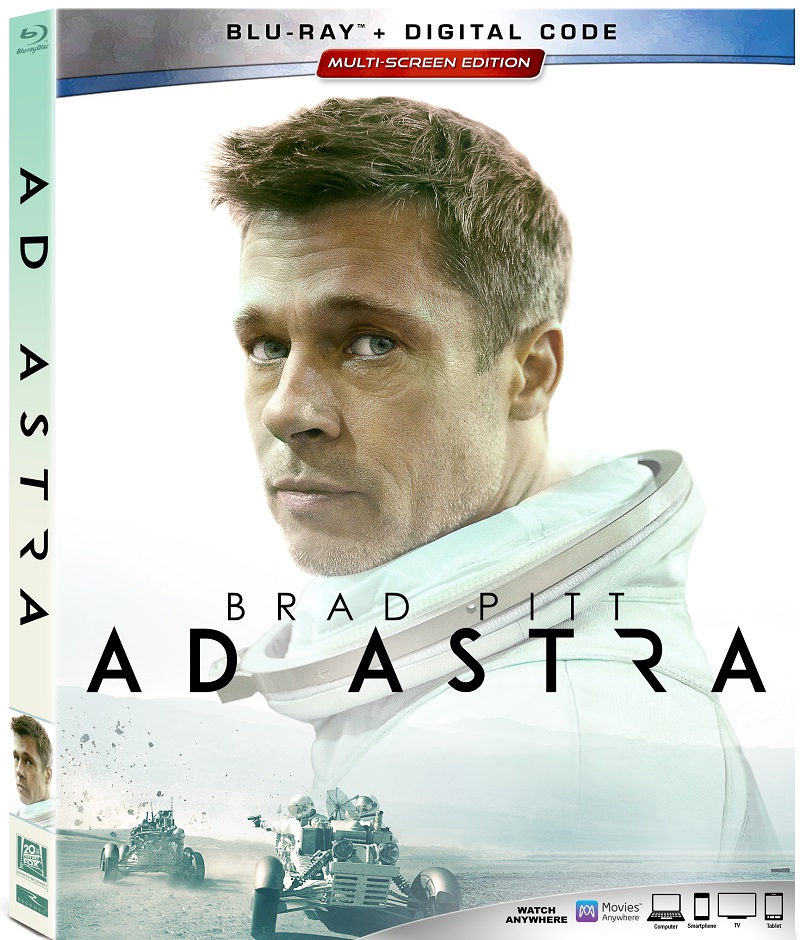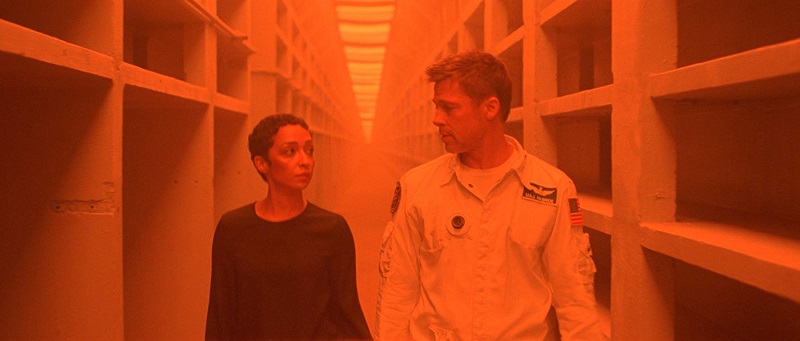Brad Pitt is having quite a 2019 … seriously, it’s one for the ages. There’s his awards worthy turn in Quentin Tarantino’s Once Upon a Time in Hollywood and his out-of-this-world role in the sci-fi drama Ad Astra—out now on DVD, Blu-Ray and digital download.

Pitt portrays Roy McBride, an astronaut who got into the business to be just like his father. H. Clifford McBride (Tommy Lee Jones) was an American hero who paid the ultimate price for pushing the envelope of exploration and science when Roy was just a boy. The older McBride was the leader of a mission charged with reaching the furthest corners of our galaxy in hopes of finding intelligent life. He, and the crew, disappeared and now it appears that his son will be saddling up to head into the great unknown because NASA believes that they have evidence that he may be alive.
It’s also under a troubling cloud that this information comes forward. There have been some unexplained disturbances across the planet. Scientists believe that they are emanating from around the site of Clifford’s last known whereabouts. Fires are burning out of control and there is also a rash of other natural disasters all spawned from electromagnetic pulses coming from deep space.
Could Roy’s dad be alive? And if he is, what has he been up to since he disappeared. More importantly—if he is behind these awful events that are consuming the globe… why?
Pitt’s turn in Ad Astra is largely the reason to witness this spectacle. That, and James Gray’s direction and co-written screenplay. The veteran actor delivers a subtlety powerful turn that is easily among his best (although not his best this year, that would be his Golden Globe nominated role in Tarantino’s flick!). Roy McBride is a complicated fellow and in the hands of Pitt, he is presented in the most passionate and rich manner. This is a man who grew up without his father but knew him just well enough before he disappeared that he had a seismic influence on him. After all, the whole reason he’s an astronaut is because of his pops. So much of what emotively drives Roy is done in his head. Normally that is a tough thing to pull off for an actor. But what Pitt does with his face, and body language in Ad Astra shows a progression and growth of the thespian in the last several years that is uncanny. He has a command of his instrument, i.e. his body—from head to toe, that is about as strong as anyone working today.
The film drags a bit in parts, but it is a relatively minor complaint compared to the dazzling production design, acting (Ruth Negga, Jones and Donald Sutherland all astound) and for fans of sci-fi, a journey into space that is unique. That is one of its most impressive aspects. Fans of this genre have literally seen it all. It takes a lot to impress space movie fanatics. Between the uniqueness of the Ad Astra story, the questions it raises about science, society and us, as well as its stunning look at the entity that is the father-son dynamic, this is a science fiction foible that is worthy of the rich cinematic legacy that came before.
Gray has quietly been compiling a film legacy all his own over the last few years that has some serious mettle. His 2016 effort, The Lost City of Z was one of my favorites of that year and showed how far he has come since we first became aware of his work in 1994 with Little Odessa, 2007’s We Own the Night and 2008’s Two Lovers. Ad Astra is a huge leap on many fronts for the writer-director. Tackling a genre that is not the easiest to navigate shows a confidence that he has rightfully earned. Some may have felt that a filmmaker may have tried to tackle too much by making this sci-fi journey as much about a father-son dynamic as a mysterious space odyssey. Yet in the hands of Gray, it works. It is largely because of that layered narrative that the entire film is so compelling.
A Man Named Roy leads off our bonus features look with its spotlight on Pitt and his characterization. Among the joys—beyond hearing the actor’s insight into his process—is some making-of footage of the superstar tied to some wire that was utilized for the “zero gravity” landscape that the actor spends much of the film inhabiting. That old adage that if the actors are enjoying themselves, so too does the audience is sure true here.
There are two featurettes that focus on the outer space aspect of Ad Astra and they wind up being perfect compliments to one another. To the Stars finds some of the cast and crew waxing poetic about the joys of making a movie centered around space travel and how for many, it was a lifelong dream fulfilled. Reach for the Stars is a fantastic, seven-minute, look at the cast and crew discussing space travel and how this project made some of them seem to give the impression they’d love to head out into the stars for real!

The Crew of the Cepheus shines a light on some of the supporting characters in the flick and gets into some scientific details about what space travel does to the human body and how the flick tried to feel as authentic as possible.
I love it when home video releases include some insight into the production design of the film. After all, without the aesthetic that production designers provide, most films would be empty vats of nothing! The Art of Ad Astra gives us an inside scoop to the processes that were undertaken to add authenticity to a space travel movie. Considering most of what we think we know about that endeavor firmly puts the fiction in science fiction, hearing what Gray and his team explored with their production design is beyond intriguing.
Considering this is firmly a Gray baby, on subsequent viewings, be sure to turn on that audio commentary track and prepare for some amazing insight into the making of Ad Astra from the man most responsible for willing it into being.
Film Grade: B
Bonus Features: B+

